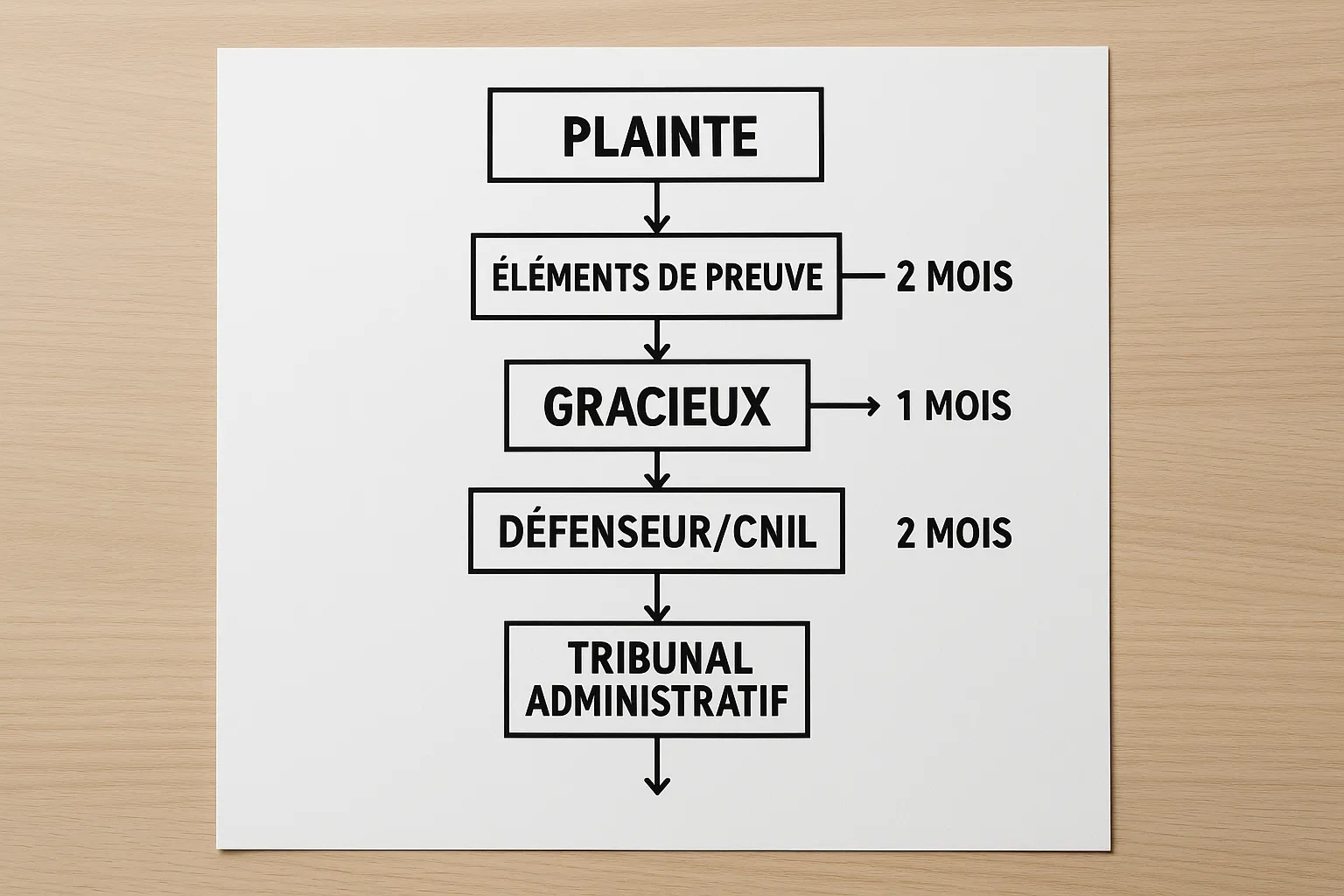Filing a Complaint Against Prefecture Misconduct: Step-By-Step

Waiting months for a receipt, being shouted at across a counter, or seeing your perfectly complete file rejected with no explanation can make anyone feel powerless. Yet French law gives every foreign resident clear tools to challenge unlawful or abusive conduct by a préfecture. This practical guide breaks down, step by step, how to file a complaint against prefecture misconduct and defend your immigration rights in 2025.
1. What Counts as Prefecture Misconduct?
Before drafting a complaint, identify exactly which legal obligation the prefecture has breached. Typical situations we see at ImmiFrance include:
- Unreasonable delay: No decision within the statutory time-limit (e.g., two months for a carte de séjour renewal). Under Article L.232-1 of the Code des relations entre le public et l’administration (CRPA), silence usually means implicit rejection, which you can contest.
- Failure to issue a récépissé when you applied on time, leaving you without legal stay.
- Refusal to accept documents that are on the official Service-Public checklist.
- Discriminatory behaviour or verbal abuse at the counter, contrary to the Défenseur des droits charter.
- Data mishandling (lost passport, documents visible in another user’s ANEF account) violating GDPR and Article L.312-1 CRPA.
- Ignoring an appointment request, despite proof of multiple attempts (see our guide on Prefecture Strike Calendar: Protect Your Deadlines).
Document the facts precisely: dates, names, screenshots, photos of the queue, recorded phone logs, and witness statements. Evidence is your best ally.
2. Legal Foundations You Can Invoke
| Source | Main Guarantees |
|---|---|
| CRPA (Articles L110-1 to L232-4) | Right to be treated with dignity, receive reasons for decisions, obtain access to your file, and challenge administrative silence. |
| CESEDA immigration code | Statutory deadlines for residence permits, obligation to issue a récépissé, right to a Commission du titre de séjour review before certain refusals. |
| Law n° 2008-496 (non-discrimination) | Prohibits differential treatment based on origin, nationality, or language. |
| GDPR & CNIL guidance | Protection of personal data you upload to ANEF. |
| Décret n° 2022-1524 (quality charter) | Sets service standards for prefecture counters and emails. |
Citing the right article in your letter signals that you know your rights—often enough to unlock a stuck file.
3. Overview of Complaint Channels
| Channel | Deadline | Free? | Typical Outcome |
|---|---|---|---|
| Recours gracieux (formal letter to the same prefect) | 2 months after the decision or implicit refusal | Yes | Decision reconsidered, file re-examined |
| Recours hiérarchique (to Ministry of the Interior) | 2 months | Yes | National oversight, sometimes faster than court |
| Défenseur des droits (independent ombudsman) | 1 year from facts | Yes | Mediation, formal recommendations |
| Tribunal administratif (contentious appeal) | 2 months (48 h for OQTF!) | Court fee €0 (legal aid possible) | Binding judgment, damages, injunction |
| CNIL complaint (data breach) | None | Yes | Order to rectify or fine the prefecture |
Most people combine channels: a swift recours gracieux to unlock the file, while preparing a court action if the silence continues.
4. Step-by-Step Complaint Roadmap
Step 1 – Diagnose and Gather Evidence (Day 0–7)
- Print or save every ANEF screen showing “en cours d’examen”.
- Download application receipts, payment proofs, La Poste tracking history (see our guide on Lost Prefecture Mail).
- Collect witness statements (model attestation 2025 form) if you faced verbal abuse.
- Request your personal file under CRPA L311-1 by email; the prefecture must reply within one month.
Step 2 – Attempt Informal Resolution (Day 7–14)
Sometimes a polite email with attachments to the “administration-accueil @ préfecture.fr” address solves the issue. Describe the facts concisely, cite the legal deadline, and request action within ten days.
Step 3 – Draft a Recours Gracieux (Day 15)
- Address the letter to Madame/Monsieur le Préfet de ….
- Identify the contested decision or silence.
- List supporting laws (CRPA L121-1 duty to provide reasons, CESEDA deadlines, etc.).
- Attach a chronology table and evidence bundle.
- Demand a written response within one month.
- Send by lettre recommandée avec avis de réception (LRAR) and keep the receipt.
Template and Word download available to ImmiFrance subscribers in the dashboard.
Step 4 – Escalate with a Recours Hiérarchique (Optional, Day 30–45)
If the prefect remains silent, write to the Direction des Libertés Publiques et des Affaires Juridiques (DLPAJ) at the Ministry of the Interior. Attach the unanswered recours gracieux and ask for supervisory intervention.
Step 5 – Seize the Défenseur des Droits (Day 30–90)
File online or visit the local delegate (over 550 offices). The process is free, uses plain language, and often triggers a mediation meeting with prefecture management. In discrimination cases, the Défenseur can demand internal documents you cannot normally access.

Step 6 – File an Appeal at the Tribunal Administratif (Day 30–60)
If two months pass without a satisfying answer—or if you received a written refusal—you can lodge a recours pour excès de pouvoir:
- Create an account on Télérecours citoyens.
- Upload your petition (PDF, signed), evidence bundle, and legal arguments.
- Tick the demande d’aide juridictionnelle box if you need free counsel.
- Watch deadlines: 48 hours for OQTF (see our in-depth guide OQTF Explained).
Many clients also file a référé-mesures utiles (Article L521-3 Code de justice administrative) to order the prefect to issue a récépissé within 72 hours.
Step 7 – Report Data Breaches to CNIL (Any Time)
If scans of your passport appear in another user’s ANEF space, submit a CNIL complaint with screenshots. The authority can fine the prefecture and force corrective action.
5. Timeline Snapshot
| Day | Action | Goal |
|---|---|---|
| 0 – 7 | Collect evidence, request your file | Build a solid record |
| 7 – 14 | Informal email | Quick solution |
| 15 | Send recours gracieux (LRAR) | Start legal clock |
| 30 | Optional recours hiérarchique | Pressure via ministry |
| 30 – 90 | Défenseur des droits | Mediation |
| 30 – 60 | Tribunal administratif | Binding ruling |
| 0 – ∞ | CNIL (if data breach) | Data protection |

6. Practical Tips to Maximise Success
- Use clear French. Courts accept English annexes, but the main brief must be in French.
- Respect formatting: numbered pages, headings, exhibit list (bordereau), and bookmarks in PDFs.
- Never miss a deadline; if you do, file a recours en relevé de forclusion citing CRPA L211-2.
- Quote jurisprudence: e.g., TA Paris, 11 March 2024, n° 2212345 ruled that failure to issue a récépissé within 48 h is a manifest error.
- Stay polite. Insults can lead to rejection as abusive (CRPA L122-5).
7. How ImmiFrance Can Assist You
Since 2018, ImmiFrance has guided over 3,000 migrants through prefecture disputes with a 78 % success rate on administrative complaints. Our offer includes:
- A personalised assessment call within 24 hours.
- Ready-to-use letter templates citing up-to-date laws.
- Document translation and certified copies.
- Appointment booking and real-time tracking of your Télérecours docket.
- Connection to our vetted network of immigration lawyers for urgent référé hearings.
Facing prefecture misconduct is daunting, but you don’t have to do it alone. Book a free 15-minute consultation on ImmiFrance and turn the law back in your favour today.
